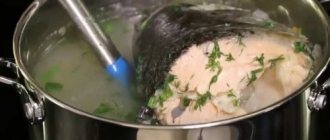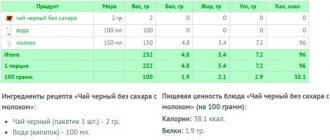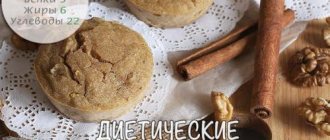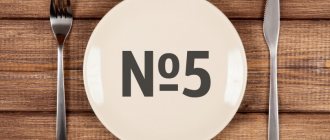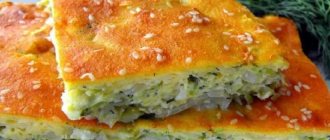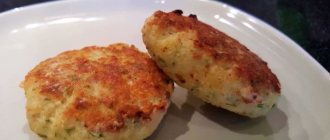How to choose zucchini for caviar
To prepare caviar from zucchini, it is better to give preference to small vegetables. In this form, they are used entirely, along with the skin and seeds. Just wash them well and start cooking. If you choose a more mature zucchini, you need to peel it from the thick peel and remove the seeds, because they are already hard.
When choosing zucchini for caviar, you need to pay attention to the weight. They should feel heavier than they look. In a high-quality product, the peel is shiny, without flaws or punctures.
Before cooking, zucchini does not need to be soaked; just wash it well under running water. This vegetable contains a large amount of moisture. To remove excess, you need to peel and chop it, add salt and leave for 15 minutes in a cool place. Before cooking, all that remains is to squeeze out the released juice.
The squash caviar appetizer has many recipes and preparation methods. With the help of various spices and vegetables, it can radically change the taste, color and aroma, depending on preferences.
Zucchini caviar for the winter with mayonnaise
Calorie content per 100 g -86.6 Proteins - 0.7 Fats - 6.0 Carbohydrates - 7.3
Take:
- 3 kg zucchini
- 0.5 kg onions
- 250 g mayonnaise
- 300 g tomato paste
- 100 g vegetable oil
- 100 g sugar
- 0.5 teaspoon. red pepper
- 2 tbsp. lie salt
Preparation:
Peel and core the zucchini and cut into large pieces
Chop the onion coarsely
Passing vegetables through a meat grinder
Add mayonnaise, tomato paste, vegetable oil
Mix everything thoroughly
Place over medium heat, bring to a boil, reduce heat and simmer, stirring for 1 hour.
Add sugar, pepper, salt
Mix everything thoroughly and simmer for another 1 hour, stirring
Place caviar in sterilized jars and seal with sterilized lids
Turn the jars over, cover with a warm cloth and leave until completely cool.
Contraindications of squash caviar
You should avoid eating such caviar only if you have an individual intolerance to the components. Most often these are carrots and tomatoes.
In most circumstances, harm to the body comes from a store-bought product of insufficient quality containing dyes, stabilizers and preservatives. These additives are dangerous and can provoke the development of cancer. Even if the manufacturer adheres to the norms and standards of preparation, it is permissible to add starch, flour, taste improvers and other components that do not benefit the body. Therefore, it is better to prefer homemade recipes.
What does squash caviar go with?
Squash caviar can be consumed for breakfast, lunch and dinner. It goes well with all types of meat, potatoes or cereals, and is great for the first meal in the morning, complementing an omelet or sandwich. Caviar goes well with various pickles or lard. This dish is often served with noodles or pasta.
Zucchini caviar can be eaten as a separate dish or complement any side dish, which is why it is very popular during fasting. It fights hunger well and saturates the body remarkably.
How to cook squash caviar: recipes
These recipes are very popular. Ready-made dishes can be served after cooking or used as preparation for the winter. The cost of such food is budget-friendly, especially if it is prepared in the summer season.
Classic caviar
Compound:
- 3 kg of zucchini;
- 1 kg carrots;
- 1 kg of onion;
- 5 pieces. tomatoes;
- 1.5 tbsp. salt;
- 1 tbsp. Sahara;
- 1 tsp citric acid;
- 200 ml vegetable oil;
- spices to taste (ground pepper, bay leaf).
Cooking instructions:
- Wash the zucchini fruits, cut off the tails, cut into slices and fry on both sides.
- Peel and grate the carrots on a coarse grater.
- Cut the onion into half rings and fry along with the carrots.
- Allow all components to cool, then grind the ingredients using a meat grinder or food processor and place in a cooking container.
- Add salt, sugar, tomatoes, citric acid, seasonings. Stir until smooth and cook over moderate heat for 15–20 minutes.
- Add herbs and garlic to taste.
For the winter
Compound:
- 3 kg of zucchini;
- 700 g carrots;
- 700 g onions;
- 5 pieces. tomatoes (can be replaced with 2 tablespoons of tomato sauce);
- 200 ml water;
- 300 ml sunflower oil;
- 3–4 tbsp. vinegar;
- 2 tbsp. salt;
- 3 tbsp. Sahara;
- spices to taste (ground pepper, bay leaf).
How to cook:
- Wash the zucchini, cut off the tails. If the fruits are young, cut them into cubes; if they are ripe, peel them and select the seeds, then grind them using a meat grinder or food processor.
- Peel the carrots and grate on a coarse grater.
- Peel the onion and cut into small squares.
- Remove the skins from the tomatoes, and crush the tomatoes themselves in a mortar or grate.
- Mix the ingredients well until smooth, add water and place on moderate heat. Cook for 30 minutes.
- Pour in oil, tomato sauce (if tomatoes are not included), salt, sugar, spices. Simmer the caviar for 35–55 minutes over low heat until thickened.
- Pour in the vinegar a few minutes before it’s ready.
- After removing from the heat, immediately place the finished caviar in a sterile container and roll up.
Video:
how to make caviar from zucchini Expand
Caviar with mayonnaise
Required:
- 3–3.5 kg of zucchini;
- 250 g mayonnaise;
- 500 g onions;
- 250 g tomato paste;
- 250 g sunflower oil;
- 2 tbsp. salt;
- 0.5 cups sugar;
- 0.5 tsp ground pepper;
- laurel
Cooking:
- Wash the zucchini fruits, cut off the tails, peel and select the seeds, then simply pass the pieces of the vegetable through a meat grinder (or you can use a food processor).
- Chop and peel the onion and immediately add the vegetable to the zucchini.
- Pour in the oil, add mayonnaise and add the above amount of tomato paste.
- Mix all the products and put the cauldron on the fire.
- Simmer for 1 hour. Next, add all the seasonings: salt, sugar, pepper, bay leaves and continue cooking the vegetable mass for another 60–70 minutes.
Ready caviar can be served hot right away, wait until it cools down, or stored in jars for the winter.
Caviar with tomato paste
Required:
- 6–6.5 kg of zucchini;
- 3 cloves of garlic;
- 500 g tomato paste;
- ½ tbsp. sunflower oil;
- 3 tbsp. salt;
- 200 g sugar;
- 0.5 tsp ground pepper;
- Bay leaf.
Cooking:
- Wash the vegetables well under running water, cut off the tails, peel the skins and select the seeds. Then pass the zucchini through a meat grinder.
- Transfer the mixture to the container chosen for stewing, add oil, tomato sauce and all seasonings.
- Send to low heat and simmer for about 30–40 minutes.
- 5-7 minutes before readiness, add finely chopped garlic.
In a slow cooker
Required:
- 2–2.5 kg of zucchini;
- 120 g carrots;
- 80–100 g of onion;
- 190–200 g tomato paste;
- 90–100 g sunflower oil;
- 10 g salt;
- 20 g sugar;
- spices to taste.
Cooking:
- Wash the zucchini fruits and cut off their tails. If the vegetables are young, cut them into cubes immediately. If they are overripe, first be sure to peel the skin and remove all the seeds inside. Then grind using a meat grinder.
- Wash the carrots thoroughly. Next, peel and grate by hand on a coarse grater.
- Chop the onion, preferably into small cubes.
- Pour oil into the multicooker bowl and fry the zucchini pieces there a little.
- Place the vegetables on a plate and separately fry the onions and carrots in a bowl, then combine all the ingredients.
- Grind the whole mass with a blender and then put it in a slow cooker for about 45–60 minutes, without covering it with a lid.
- Then add all the seasonings. Simmer for another half hour.
Let it cool and you can eat.
In the oven
What you will need:
- 3 pcs. medium-sized zucchini;
- 3 pcs. medium carrots;
- 3 pcs. Luke;
- 3 pcs. sweet pepper;
- 5 pieces. tomatoes;
- 120 g olive/sunflower oil;
- 10 g salt;
- 20 g sugar;.
- spices to taste.
Cooking:
- Wash the zucchini fruits, peel and remove seeds, cut into four parts and place on a baking sheet.
- Peel the carrots, cut into small lengthwise slices and add to the zucchini.
- Wash the pepper, select the core, cut into lengthwise pieces and place on a baking sheet with the rest of the ingredients.
- Peel the onion, cut into 4 parts and place on a baking sheet with the remaining ingredients.
- Add tomatoes cut into medium-sized slices.
- Pour sunflower oil over all ingredients and place in the oven at 180°C for 60 minutes.
- Remove the vegetables into a metal container using a slotted spoon (the juice that has been released is no longer needed), add sugar, salt, spices and beat with a blender.
- Put on fire, bring to a boil. If you want to leave this squash caviar for the winter, add 3 tbsp. vinegar and put into jars.
Video:
how to make delicious squash caviar Expand
Unusual squash caviar for the winter
Compound:
- 5 kg of zucchini;
- 1 kg carrots;
- 1 kg of onion;
- 500 g mayonnaise;
- 0.5 kg of tomato sauce;
- 200 ml olive/sunflower oil;
- 0.5 tsp ground pepper;
- 100 g chicken seasoning;
- 0.5 tbsp. garlic
Preparation procedure:
- Wash and peel the zucchini fruits, onions and carrots.
- Using a meat grinder or food processor, grind and mix well.
- Cook for 2 hours over low heat.
- Pour in mayonnaise, tomato paste, seasoning, pepper and sunflower oil. Mix and leave to cook for half an hour.
- After adding the garlic, cook for 10 minutes.
- Place in sterilized containers and roll up.
Squash caviar with pumpkin
Ingredients for preparation:
- 400 g zucchini;
- 350 g pumpkin;
- 3 pcs. sweet pepper;
- 1 tbsp. tomato sauce;
- 50 g olive oil;
- 0.5 tsp ground pepper;
- 2 cloves of garlic;
- 1 tbsp. salt.
Cooking:
- Wash the pumpkin and zucchini, remove the peel and seeds, cut into large pieces and place on a baking sheet.
- Wash the peppers and place them whole on a baking sheet with the other ingredients.
- Peel the garlic, add to a common baking sheet and pour oil over all ingredients.
- Place the vegetables in the oven at 180°C for half an hour.
- Remove the vegetables and place them in a chopping container. First remove skin and seeds from the pepper.
- Grind with a blender.
- Add salt, tomato sauce, garlic and pepper. After boiling, cook for 35 minutes until thickened.
Zucchini caviar as store-bought
Compound:
- 3 kg of zucchini;
- 1 kg carrots;
- 1 kg of onion;
- 3 tbsp. tomato paste;
- 50 g vegetable oil;
- 1 tbsp. vinegar;
- 1 tbsp. fine salt.
Cooking:
- Clean all ingredients and remove tails.
- Send one by one to the frying pan.
- Grind the fried ingredients using a blender or food processor.
- Place in a large saucepan, add salt and put on fire. Cook for 40 minutes.
- After 20 minutes of boiling, add tomato sauce and vinegar.
- Pour into sterilized containers and roll up.
Squash caviar with cherry plum
Compound:
- 1 kg of zucchini;
- 1 PC. chili pepper;
- 2 pcs. Luke;
- 6 pcs. tomatoes;
- 3 tbsp. vegetable oil;
- 200 g cherry plum;
- 2 tbsp. Sahara;
- 1 tbsp. salt;
- 3 cloves of garlic.
Cooking according to instructions:
- Wash the cherry plum, pour boiling water over it and blanch for up to 4 minutes.
- Cut the onions into small cubes.
- Peel and coarsely grate the zucchini.
- Place the onion in a frying pan with oil and fry for 5 minutes, then add the zucchini and fry for 20 minutes.
- Grind the tomatoes using a blender.
- Pour cherry plum into the pan with vegetables.
- Add tomato puree, sugar, salt and simmer for 10 minutes.
- Grind the garlic and chili pepper and add to a common container.
Let it cool and you can eat.
Video:
how to prepare caviar from zucchini for the winter Expand
Recipe: Zucchini caviar PP. Calorie, chemical composition and nutritional value.
Nutritional value and chemical composition of “Zucchini caviar PP”.
The table shows the nutritional content (calories, proteins, fats, carbohydrates, vitamins and minerals) per 100 grams of edible portion.
| Nutrient | Quantity | Norm** | % of the norm in 100 g | % of the norm in 100 kcal | 100% normal |
| Calorie content | 41.1 kcal | 1684 kcal | 2.4% | 5.8% | 4097 g |
| Squirrels | 0.9 g | 76 g | 1.2% | 2.9% | 8444 g |
| Fats | 1.9 g | 56 g | 3.4% | 8.3% | 2947 g |
| Carbohydrates | 4.9 g | 219 g | 2.2% | 5.4% | 4469 g |
| Organic acids | 0.1 g | ~ | |||
| Alimentary fiber | 1.6 g | 20 g | 8% | 19.5% | 1250 g |
| Water | 88 g | 2273 g | 3.9% | 9.5% | 2583 g |
| Ash | 0.452 g | ~ | |||
| Vitamins | |||||
| Vitamin A, RE | 212.1 mcg | 900 mcg | 23.6% | 57.4% | 424 g |
| beta carotene | 1.274 mg | 5 mg | 25.5% | 62% | 392 g |
| Vitamin B1, thiamine | 0.028 mg | 1.5 mg | 1.9% | 4.6% | 5357 g |
| Vitamin B2, riboflavin | 0.03 mg | 1.8 mg | 1.7% | 4.1% | 6000 g |
| Vitamin B4, choline | 9.55 mg | 500 mg | 1.9% | 4.6% | 5236 g |
| Vitamin B5, pantothenic | 0.108 mg | 5 mg | 2.2% | 5.4% | 4630 g |
| Vitamin B6, pyridoxine | 0.093 mg | 2 mg | 4.7% | 11.4% | 2151 g |
| Vitamin B9, folates | 5.621 mcg | 400 mcg | 1.4% | 3.4% | 7116 g |
| Vitamin C, ascorbic acid | 3.72 mg | 90 mg | 4.1% | 10% | 2419 g |
| Vitamin E, alpha tocopherol, TE | 0.879 mg | 15 mg | 5.9% | 14.4% | 1706 g |
| Vitamin H, biotin | 0.517 mcg | 50 mcg | 1% | 2.4% | 9671 g |
| Vitamin K, phylloquinone | 5 mcg | 120 mcg | 4.2% | 10.2% | 2400 g |
| Vitamin RR, NE | 0.6106 mg | 20 mg | 3.1% | 7.5% | 3275 g |
| Niacin | 0.489 mg | ~ | |||
| Macronutrients | |||||
| Potassium, K | 203.12 mg | 2500 mg | 8.1% | 19.7% | 1231 g |
| Calcium, Ca | 20.64 mg | 1000 mg | 2.1% | 5.1% | 4845 g |
| Silicon, Si | 17.747 mg | 30 mg | 59.2% | 144% | 169 g |
| Magnesium, Mg | 12.66 mg | 400 mg | 3.2% | 7.8% | 3160 g |
| Sodium, Na | 3.72 mg | 1300 mg | 0.3% | 0.7% | 34946 g |
| Sera, S | 11.77 mg | 1000 mg | 1.2% | 2.9% | 8496 g |
| Phosphorus, Ph | 24.4 mg | 800 mg | 3.1% | 7.5% | 3279 g |
| Chlorine, Cl | 9.24 mg | 2300 mg | 0.4% | 1% | 24892 g |
| Microelements | |||||
| Aluminium, Al | 129.8 mcg | ~ | |||
| Bor, B | 58.5 mcg | ~ | |||
| Vanadium, V | 11.46 mcg | ~ | |||
| Iron, Fe | 0.5 mg | 18 mg | 2.8% | 6.8% | 3600 g |
| Yod, I | 0.83 mcg | 150 mcg | 0.6% | 1.5% | 18072 g |
| Cobalt, Co | 1.885 mcg | 10 mcg | 18.9% | 46% | 531 g |
| Lithium, Li | 0.527 mcg | ~ | |||
| Manganese, Mn | 0.1153 mg | 2 mg | 5.8% | 14.1% | 1735 g |
| Copper, Cu | 57.72 mcg | 1000 mcg | 5.8% | 14.1% | 1733 g |
| Molybdenum, Mo | 3.142 mcg | 70 mcg | 4.5% | 10.9% | 2228 g |
| Nickel, Ni | 1.642 mcg | ~ | |||
| Rubidium, Rb | 89.4 mcg | ~ | |||
| Selenium, Se | 0.355 mcg | 55 mcg | 0.6% | 1.5% | 15493 g |
| Strontium, Sr | 0.74 mcg | ~ | |||
| Fluorine, F | 11.83 mcg | 4000 mcg | 0.3% | 0.7% | 33812 g |
| Chromium, Cr | 1.28 mcg | 50 mcg | 2.6% | 6.3% | 3906 g |
| Zinc, Zn | 0.3769 mg | 12 mg | 3.1% | 7.5% | 3184 g |
| Digestible carbohydrates | |||||
| Starch and dextrins | 0.307 g | ~ | |||
| Mono- and disaccharides (sugars) | 5 g | max 100 g | |||
| Glucose (dextrose) | 0.488 g | ~ | |||
| Sucrose | 1.454 g | ~ | |||
| Fructose | 0.307 g | ~ | |||
| Essential amino acids | 0.081 g | ~ | |||
| Arginine* | 0.031 g | ~ | |||
| Valin | 0.009 g | ~ | |||
| Histidine* | 0.004 g | ~ | |||
| Isoleucine | 0.01 g | ~ | |||
| Leucine | 0.013 g | ~ | |||
| Lysine | 0.014 g | ~ | |||
| Methionine | 0.003 g | ~ | |||
| Methionine + Cysteine | 0.005 g | ~ | |||
| Threonine | 0.01 g | ~ | |||
| Tryptophan | 0.004 g | ~ | |||
| Phenylalanine | 0.01 g | ~ | |||
| Phenylalanine+Tyrosine | 0.017 g | ~ | |||
| Nonessential amino acids | 0.174 g | ~ | |||
| Alanin | 0.015 g | ~ | |||
| Aspartic acid | 0.026 g | ~ | |||
| Glycine | 0.01 g | ~ | |||
| Glutamic acid | 0.062 g | ~ | |||
| Proline | 0.008 g | ~ | |||
| Serin | 0.008 g | ~ | |||
| Tyrosine | 0.007 g | ~ | |||
| Cysteine | 0.003 g | ~ | |||
| Sterols (sterols) | |||||
| beta sitosterol | 3.293 mg | ~ | |||
| Saturated fatty acids | |||||
| Saturated fatty acids | 0.3 g | max 18.7 g | |||
| 16:0 Palmitinaya | 0.102 g | ~ | |||
| 18:0 Stearic | 0.068 g | ~ | |||
| 20:0 Arakhinovaya | 0.005 g | ~ | |||
| 22:0 Begenovaya | 0.012 g | ~ | |||
| Monounsaturated fatty acids | 0.392 g | min 16.8 g | 2.3% | 5.6% | |
| 18:1 Oleic (omega-9) | 0.39 g | ~ | |||
| Polyunsaturated fatty acids | 1.07 g | from 11.2 to 20.6 g | 9.6% | 23.4% | |
| 18:2 Linolevaya | 0.985 g | ~ | |||
| Omega-6 fatty acids | 1 g | from 4.7 to 16.8 g | 21.3% | 51.8% |
The energy value of squash caviar PP is 41.1 kcal.
Primary Source: Created in the application by the user. Read more.
** This table shows the average levels of vitamins and minerals for an adult. If you want to know the norms taking into account your gender, age and other factors, then use the “My Healthy Diet” application.
Culinary secrets of cooking
- Before you start cooking, you need to put the ingredients in one large container and let them release the juice. Then simmer the future dish in its own juice.
- Vegetable oil should be added at the end of cooking. This will make the zucchini more tender and delicate. Thanks to this method, heartburn will not bother you.
- If you diversify the zucchini with eggplants and squash, the taste will be much more unusual and rich. A good solution would be to add tomatoes along with tomato paste and bell pepper. The more vegetables, the tastier.
- Those who like sweeter caviar should give preference to recipes with a lot of carrots.
- If the composition does not include citric acid or vinegar, the shelf life is reduced.
- If you want to use the dietary option, you need to avoid frying, giving preference to stewing the food.
- Adding apple cider vinegar instead of the usual table vinegar will make the caviar more flavorful.
Spices and additives
- The main criterion that you need to rely on when choosing spices is individual preference and your own taste.
- Dill and cilantro go well with squash caviar. Often chopped ginger or garlic is added during cooking.
- A very tasty combination with apples. For this recipe you need to add just one fruit or replace half the onion with apples.
- Cloves, cinnamon and coriander will wonderfully improve the taste of the finished dish. You can also add a bay leaf by placing it in the jar before filling with squash caviar.
Squash caviar in the oven
The specificity of caviar cooked in the oven is the taste of baked vegetables, which cannot be compared with the taste of either fried or stewed zucchini, carrots and peppers. It is also believed that baked products are healthier than those cooked in a frying pan, since they do not contain excess oil.
Ingredients:
Squash caviar from the oven
- zucchini - 1500 g (2 large);
- tomatoes - 500 g (5 pieces);
- bell pepper - 300 g (3 medium);
- carrots - 100 g (2 medium);
- onions - 100 g (2 onions);
- salt - 15 g (level tablespoon);
- sugar - 7 g (heaped teaspoon);
- vegetable oil - to pour on top of vegetables;
- spices and herbs to taste.
Preparation:
- Peel the zucchini from seeds and peel if the fruit is ripe. Cut into large slices approximately 10 cm long, 2 cm in diameter. Place on a baking sheet.
- Peel the carrots and remove the seeds and stems from the peppers. Cut carrots and peppers into quarters. Place the zucchini evenly on top of the baking sheet.
- Cut the tomatoes into eight large pieces and place them on top of a baking sheet. The onion is either the same or in large rings, but you need to take into account that it burns strongly during cooking and can give off bitterness.
- Drizzle oil over vegetables.
- Place a baking sheet in an oven preheated to 180 degrees and bake for 1 hour, checking periodically.
- When the vegetables are ready, get rid of excess oil and juice and place all the vegetables in the pan.
- Salt, pepper, add sugar, spices. Grind with a blender until smooth.
- Place the pan on the heat and cook the mixture for three minutes.
- Roll the finished caviar into jars and place in a dark, warm place.
Features of storing workpieces
An important component of winter preparations is their storage. One of the main criteria is the selection of quality ingredients. If you choose the right vegetables, they will behave wonderfully in canned form.
The second thing you need to pay attention to is the storage location and temperature. The optimal place would be a basement with a temperature of 0 to 15 degrees. It is almost impossible to store preserved food in an apartment. Let's consider the basic storage rules:
- Cans of preserves should be placed in a cool, dry place, away from heating appliances. The room must be ventilated and protected from excess moisture. Possible storage on an insulated balcony.
- Cans should not be stored at sub-zero temperatures, otherwise there is a risk that they will crack. If there is little preservation, it can be placed in the refrigerator.
- Note! It is important to avoid direct sunlight.
After sealing the canned food and determining its storage location, you need to periodically check its condition. If cloudiness, foam or bubbles appear inside the jar, it means that the product inside has deteriorated and must be disposed of. It is also unacceptable to use the product with a swollen lid.
Before placing the workpieces, you should check the quality of the seaming. To do this, you need to turn the jar upside down and check the tightness. If necessary, roll up the jar again.
Shelf life
Canned vegetables can be stored from a month to one year. With proper storage organization, the preparations remarkably retain their quality and taste and delight us until spring.
If you intend to use a purchased product, you must pay attention to the expiration date and date of manufacture. Squash caviar should be produced during the ripening season of the vegetable, namely in summer or early autumn. If the label indicates the production time from November to May, you should doubt the quality and naturalness of the product. You should choose glass, transparent jars. Thus, you can see the color and consistency of the caviar, the presence of foreign impurities. You need to pay attention to the inscriptions about sterilization of the product; if it is missing, it is better to avoid such a purchase. After opening, the caviar must be refrigerated for no more than three days.
Freezing
Zucchini caviar can be frozen. But only if the dish is homemade. Before freezing, you need to cool the product, put it in a container or plastic bag and close it carefully. After freezing, zucchini caviar does not lose its taste and consistency. Often, after defrosting, vegetable oil is released; you just need to stir the dish until smooth.
Storing zucchini
When stored properly, the vegetable is preserved quite well. Zucchini should be placed in a cool room, while avoiding direct sunlight and frost. Thus, it will be possible to prepare fresh caviar from zucchini throughout the year until the new harvest. The remaining ingredients (onions and carrots) have a long shelf life and will delight you with their freshness and richness of taste.

